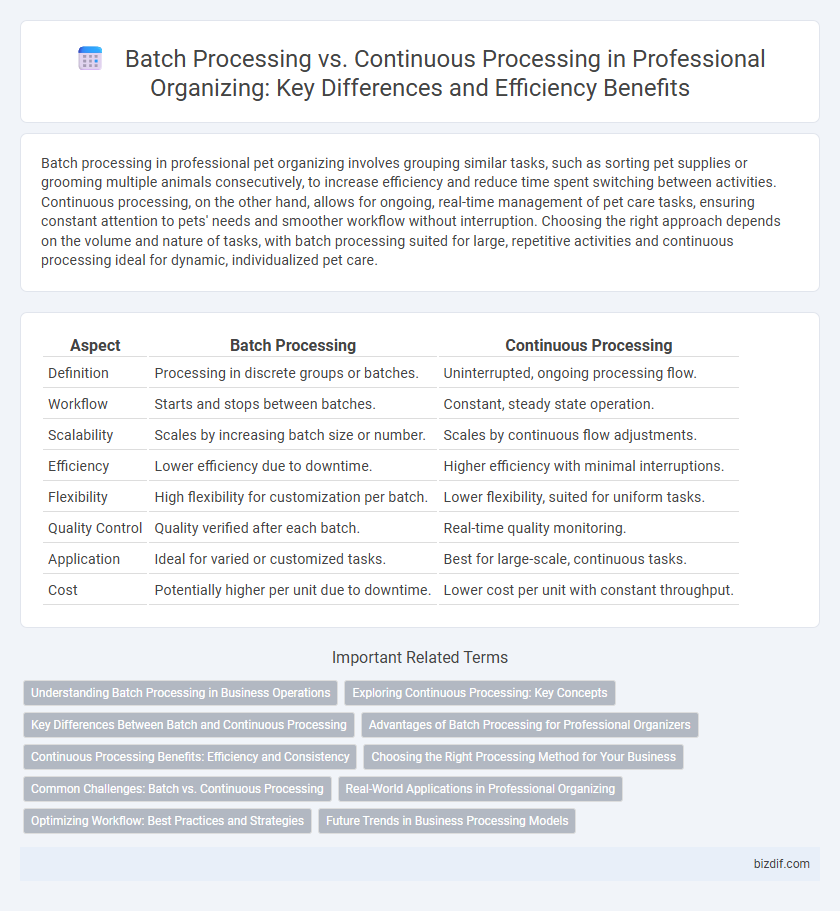Batch processing in professional pet organizing involves grouping similar tasks, such as sorting pet supplies or grooming multiple animals consecutively, to increase efficiency and reduce time spent switching between activities. Continuous processing, on the other hand, allows for ongoing, real-time management of pet care tasks, ensuring constant attention to pets' needs and smoother workflow without interruption. Choosing the right approach depends on the volume and nature of tasks, with batch processing suited for large, repetitive activities and continuous processing ideal for dynamic, individualized pet care.
Table of Comparison
| Aspect | Batch Processing | Continuous Processing |
|---|---|---|
| Definition | Processing in discrete groups or batches. | Uninterrupted, ongoing processing flow. |
| Workflow | Starts and stops between batches. | Constant, steady state operation. |
| Scalability | Scales by increasing batch size or number. | Scales by continuous flow adjustments. |
| Efficiency | Lower efficiency due to downtime. | Higher efficiency with minimal interruptions. |
| Flexibility | High flexibility for customization per batch. | Lower flexibility, suited for uniform tasks. |
| Quality Control | Quality verified after each batch. | Real-time quality monitoring. |
| Application | Ideal for varied or customized tasks. | Best for large-scale, continuous tasks. |
| Cost | Potentially higher per unit due to downtime. | Lower cost per unit with constant throughput. |
Understanding Batch Processing in Business Operations
Batch processing in business operations involves collecting and processing data or tasks in groups at scheduled intervals, enhancing efficiency by minimizing setup times and resource changes. This method suits environments with repetitive, high-volume tasks such as payroll, inventory updates, and billing cycles, where immediate processing is not critical. By optimizing workflows through batch scheduling, businesses reduce operational costs and improve accuracy by limiting manual intervention.
Exploring Continuous Processing: Key Concepts
Continuous processing in professional organizing emphasizes maintaining a steady flow of tasks, reducing clutter buildup by addressing items as they arise. This method improves efficiency by minimizing the need for large-scale sorting sessions and fosters habit formation for sustained organization. Implementing continuous processing leverages techniques such as immediate filing, real-time categorization, and regular decluttering intervals to ensure ongoing orderliness.
Key Differences Between Batch and Continuous Processing
Batch processing handles tasks in discrete groups or sets, allowing for organized, scheduled workflows ideal for managing large volumes of items at once. Continuous processing operates non-stop, maintaining a steady flow of work that maximizes efficiency and reduces downtime, suitable for environments requiring constant output. Key differences include timing of operation, system complexity, and flexibility, with batch processing offering greater control and continuous processing providing higher throughput.
Advantages of Batch Processing for Professional Organizers
Batch processing allows professional organizers to efficiently group similar tasks, reducing setup time and minimizing distractions during organizing sessions. This method increases productivity by enabling focused work on multiple items or projects at once, leading to faster completion times. It also facilitates better resource allocation, as organizers can plan their tools and materials in advance for each batch, improving overall workflow management.
Continuous Processing Benefits: Efficiency and Consistency
Continuous processing enhances professional organizing by maintaining a steady workflow, reducing downtime and increasing overall efficiency. This method ensures consistency in task execution, allowing organizers to uphold high standards and deliver uniform results. The continuous system minimizes errors and streamlines time management, making it ideal for managing large-scale organizing projects.
Choosing the Right Processing Method for Your Business
Selecting the appropriate processing method significantly impacts productivity and workflow efficiency in professional organizing businesses. Batch processing suits tasks involving grouping similar items or activities, such as sorting paperwork or inventory management, enhancing focus and reducing setup time. Continuous processing supports ongoing tasks that require uninterrupted attention, like real-time client scheduling or material handling, ensuring consistent progress without delays.
Common Challenges: Batch vs. Continuous Processing
Batch processing often encounters delays and resource bottlenecks due to task accumulation, while continuous processing faces challenges in maintaining consistent quality and real-time monitoring. Both methods struggle with scalability and error detection but require tailored strategies for workflow optimization. Effective professional organizing solutions prioritize minimizing downtime in batch systems and enhancing automation accuracy in continuous processes.
Real-World Applications in Professional Organizing
Batch processing in professional organizing involves sorting and categorizing large quantities of items in one session, ideal for decluttering entire rooms or managing seasonal wardrobe changes efficiently. Continuous processing suits daily organization tasks such as maintaining filing systems or managing incoming paperwork, ensuring ongoing order and minimizing clutter buildup. Real-world applications show batch processing maximizes productivity during major projects, while continuous processing supports sustained organization with minimal disruption.
Optimizing Workflow: Best Practices and Strategies
Batch processing in professional organizing involves grouping similar tasks together to maximize efficiency, reduce setup time, and maintain focus, making it ideal for repetitive activities like sorting or filing. Continuous processing ensures a steady workflow by addressing tasks as they arise, which helps prevent backlog and supports ongoing maintenance of organized spaces. Combining batch and continuous processing strategies optimizes workflow by balancing task intensity with flexibility, resulting in improved productivity and sustained order.
Future Trends in Business Processing Models
Batch processing remains valuable for handling large volumes of data in scheduled intervals, supporting efficient resource allocation and minimizing downtime. Continuous processing is gaining momentum as businesses demand real-time data updates and faster decision-making, driven by advancements in AI and cloud computing. Future trends indicate a hybrid approach leveraging both methods for optimal flexibility, scalability, and responsiveness in professional organizing and business process management.
Batch processing vs Continuous processing Infographic

 bizdif.com
bizdif.com